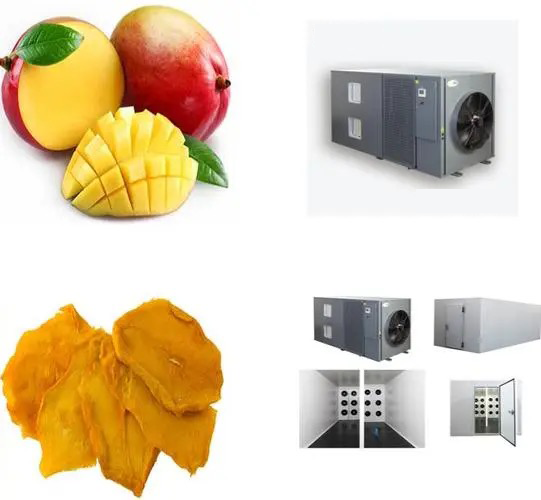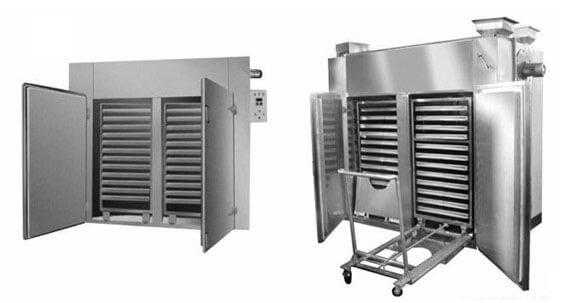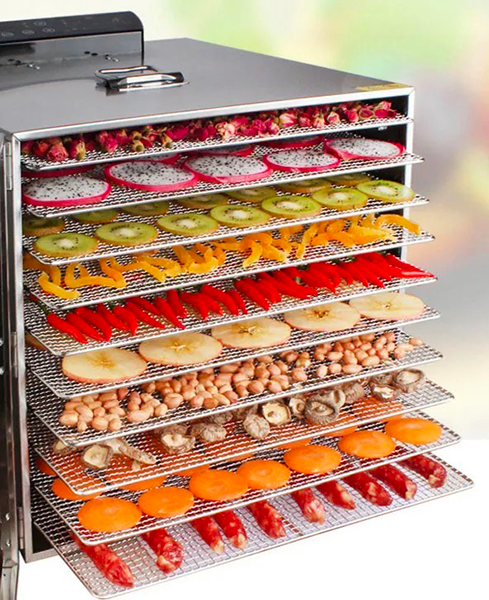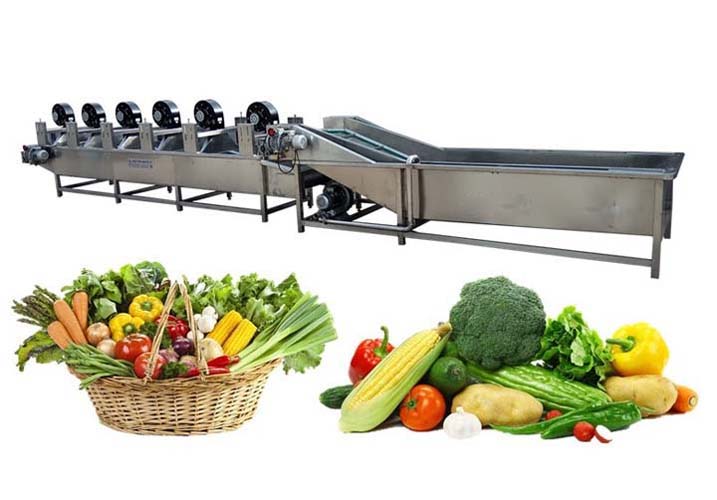
Content Menu
● Introduction
● Understanding Fruit and Vegetable Dryer Machines
>> How Does a Fruit and Vegetable Dryer Machine Work?
● Types of Fruit and Vegetable Dryer Machines
>> 1. Commercial Food Dehydrators
>> 2. Solar Fruit Dryers
>> 3. Freeze-Drying Machines
>> 4. Multi-Layer Food Dehydration Machines
● Benefits of Using a Fruit and Vegetable Dryer Machine
● Choosing the Right Fruit and Vegetable Dryer Machine
● Tips for Using Your Fruit and Vegetable Dryer Machine
● The Future of Fruit and Vegetable Drying Technology
● Conclusion
● Frequently Asked Questions
>> 1. What are the best fruits and vegetables for drying?
>> 2. How long does it take to dry fruits and vegetables in a dryer machine?
>> 3. Are dried fruits and vegetables as nutritious as fresh ones?
>> 4. How do I clean and maintain my fruit and vegetable dryer machine?
>> 5. Can I use a fruit and vegetable dryer machine for other foods?
Introduction
In today's fast-paced world, the demand for healthy, convenient, and long-lasting food options has never been higher. Enter the fruit and vegetable dryer machine, a revolutionary technology that's transforming the way we preserve our favorite produce. These innovative devices are not just changing the game for home cooks but are also making waves in the commercial food industry. In this comprehensive guide, we'll explore the ins and outs of fruit and vegetable dryer machines, their benefits, and how they're shaping the future of food preservation.
Understanding Fruit and Vegetable Dryer Machines
A fruit and vegetable dryer machine, also known as a food dehydrator, is a device designed to remove moisture from fruits, vegetables, and other food items. This process extends the shelf life of produce while preserving its nutritional value and flavor. From small countertop units for home use to large industrial fruit drying equipment, these machines come in various sizes and capacities to suit different needs.
How Does a Fruit and Vegetable Dryer Machine Work?
The basic principle behind a fruit and vegetable dryer machine is simple yet effective. Here's a step-by-step breakdown of the process:
1. Preparation: Fruits and vegetables are washed, peeled (if necessary), and sliced into uniform pieces.
2. Arrangement: The prepared produce is spread out on trays within the dryer.
3. Heat Application: The machine circulates warm air around the food items.
4. Moisture Removal: As the warm air passes over the produce, it draws out moisture.
5. Air Circulation: Fans within the machine ensure even distribution of heat and continuous air flow.
6. Time: Depending on the type of produce and desired level of dryness, the process can take anywhere from a few hours to a day or more.

Types of Fruit and Vegetable Dryer Machines
There are several types of fruit and vegetable dryer machines available in the market, each with its own unique features and benefits:
1. Commercial Food Dehydrators
These large-scale machines are designed for industrial use, capable of processing large quantities of fruits and vegetables at once. They often feature multiple trays and advanced temperature control systems for optimal drying results.
2. Solar Fruit Dryers
Harnessing the power of the sun, these eco-friendly dryers are an excellent option for areas with abundant sunlight. They're cost-effective and energy-efficient, making them popular in developing countries and among environmentally conscious consumers.
3. Freeze-Drying Machines
Utilizing advanced technology, freeze-drying machines remove moisture from fruits and vegetables at very low temperatures. This method preserves the nutritional content and flavor of the produce better than traditional drying methods.
4. Multi-Layer Food Dehydration Machines
These versatile machines feature multiple trays stacked vertically, allowing for the simultaneous drying of different types of fruits and vegetables. They're ideal for home use or small-scale commercial operations.
Benefits of Using a Fruit and Vegetable Dryer Machine
The popularity of fruit and vegetable dryer machines continues to grow, and for good reason. Here are some of the key benefits:
1. Extended Shelf Life: Dried fruits and vegetables can last for months or even years when stored properly.
2. Nutritional Preservation: The drying process retains most of the nutrients found in fresh produce.
3. Space-Saving: Dried foods take up less storage space compared to their fresh counterparts.
4. Cost-Effective: Buying produce in bulk and drying it can lead to significant savings over time.
5. Versatility: Dried fruits and vegetables can be used in a variety of recipes, from snacks to baked goods.
6. Reduced Food Waste: By drying excess produce, you can prevent spoilage and reduce food waste.
Choosing the Right Fruit and Vegetable Dryer Machine
When selecting a fruit and vegetable dryer machine, consider the following factors:
1. Capacity: Determine how much produce you plan to dry regularly.
2. Size: Consider the available space in your kitchen or facility.
3. Energy Efficiency: Look for models with good energy ratings to save on electricity costs.
4. Temperature Control: Opt for machines with adjustable temperature settings for different types of produce.
5. Ease of Use: Choose a model with user-friendly controls and easy-to-clean components.
6. Noise Level: Some machines can be noisy, so consider this if it's a concern for your environment.

Tips for Using Your Fruit and Vegetable Dryer Machine
To get the most out of your fruit and vegetable dryer machine, follow these tips:
1. Prepare produce uniformly: Cut fruits and vegetables into even pieces for consistent drying.
2. Avoid overloading: Leave space between items on the trays for proper air circulation.
3. Rotate trays: If your machine doesn't have a rotating feature, manually rotate the trays periodically for even drying.
4. Pre-treat certain fruits: Dip fruits like apples and pears in lemon juice to prevent browning.
5. Store properly: Once dried, store your fruits and vegetables in airtight containers in a cool, dark place.
The Future of Fruit and Vegetable Drying Technology
As technology advances, so does the field of food preservation. Here are some exciting developments in fruit and vegetable drying technology:
1. Smart Dryers: IoT-enabled dryers that can be controlled and monitored via smartphone apps.
2. Hybrid Systems: Machines that combine different drying methods for optimal results.
3. Eco-Friendly Solutions: More energy-efficient models and increased use of renewable energy sources.
4. Improved Sensors: Advanced sensors for precise moisture and temperature control.
5. Artificial Intelligence: AI-powered systems that can optimize drying cycles based on the specific characteristics of each batch of produce.
Conclusion
Fruit and vegetable dryer machines have revolutionized the way we preserve food, offering a convenient, efficient, and cost-effective solution for both home cooks and commercial food producers. As technology continues to evolve, we can expect even more innovative features and improved performance from these essential kitchen appliances. Whether you're looking to reduce food waste, save money, or simply enjoy your favorite fruits and vegetables year-round, a fruit and vegetable dryer machine is a worthwhile investment that can transform your approach to food preservation.

Frequently Asked Questions
1. What are the best fruits and vegetables for drying?
Answer: While most fruits and vegetables can be dried, some of the best options include apples, bananas, berries, tomatoes, carrots, and herbs. These items tend to retain their flavor well and have a good texture when dried.
2. How long does it take to dry fruits and vegetables in a dryer machine?
Answer: The drying time can vary depending on the type of produce, its moisture content, and the specific dryer machine used. Generally, it can take anywhere from 6 to 24 hours. Fruits typically take longer to dry than vegetables due to their higher sugar content.
3. Are dried fruits and vegetables as nutritious as fresh ones?
Answer: While some nutrients may be lost during the drying process, dried fruits and vegetables retain most of their nutritional value. In fact, the concentration of certain nutrients can increase as the water is removed. However, it's important to note that the calorie density also increases, so portion control is key.
4. How do I clean and maintain my fruit and vegetable dryer machine?
Answer: Most dryer machines have removable trays that can be washed with warm, soapy water. The interior of the machine should be wiped down with a damp cloth after each use. Always ensure the machine is unplugged before cleaning. Regular maintenance, such as checking the fan and heating elements, can help prolong the life of your machine.
5. Can I use a fruit and vegetable dryer machine for other foods?
Answer: Yes, many fruit and vegetable dryer machines are versatile and can be used for a variety of foods. In addition to fruits and vegetables, you can dry herbs, make jerky from lean meats, dry flowers for crafts, or even make your own fruit leather. Always check your machine's manual for specific guidelines on drying different types of foods.












